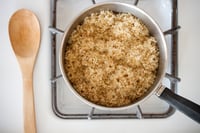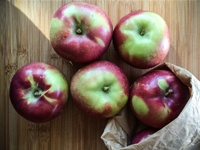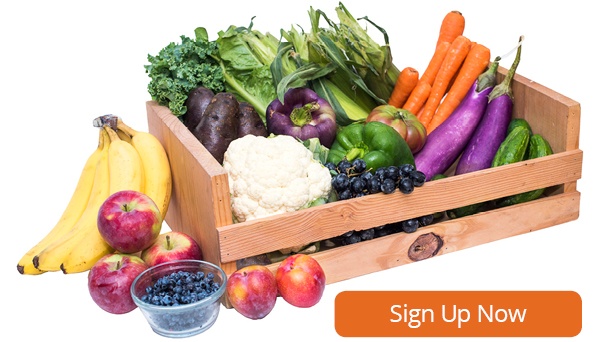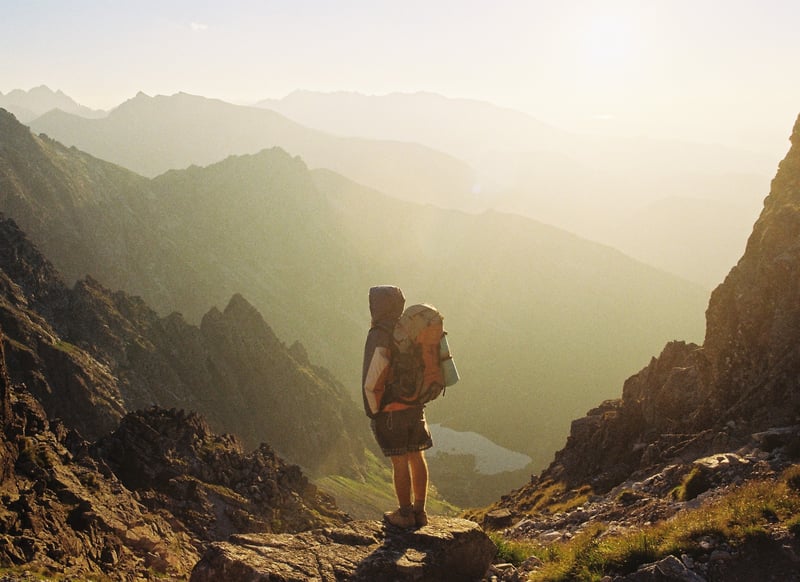
Camping is full of contradictions that somehow make a lot of sense. For example:
- The farther you get from civilization, the closer you feel to the people you’re with.
- The earlier you wake up, the more energy you seem to have.
- The more serene it is, the more alive you feel.
But there’s one part of camping that just doesn’t add up. We go into the woods to clear our minds and fill our lungs with clean air, but then we fill our stomachs with candy bars and hot dogs. After going through all this trouble to connect to nature, why is traditional camping food so processed and unhealthy?
It doesn’t have to be this way. In fact, it’s relatively easy to eat healthy food when camping, as long as you’re conscious about it and plan ahead. Here are a few tips to help you eat healthy in the great outdoors. Scroll down to find our sample menu for a weekend camping trip.
How to Eat Healthy In the Great Outdoors
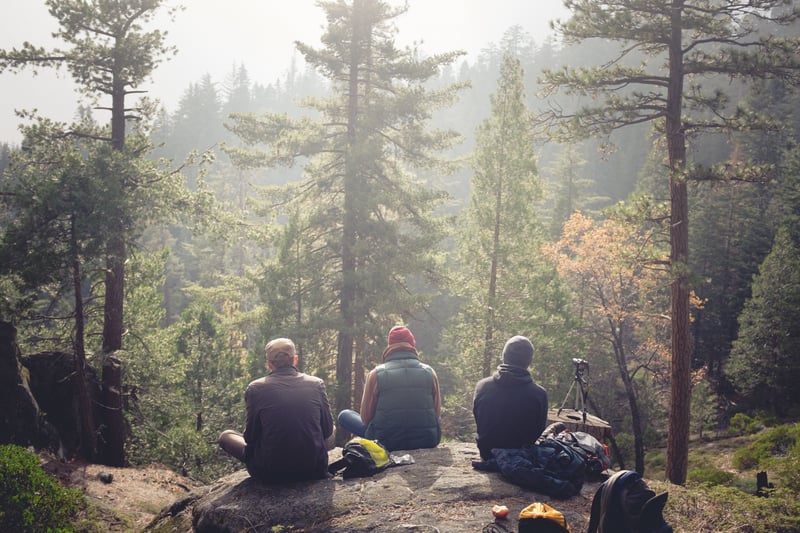
1. Plan out each meal before you go
Consider how many people you need to feed and whether or not they have any dietary restrictions (gluten-free, vegetarian or kids that are picky eaters). As Greatist points out, “While things like weather, wildlife and other aspects of the natural world may not be predictable, well-planned meals won’t ever let a camper down.”
2. Consider portion size
If this is an active camping trip, you’re probably going to want to consume a few extra calories to give your body the energy it needs to hike, climb and swim all day long. At the same time, you don’t want to bring more food than you’ll need because leftover camping food never tastes as good once you bring it indoors.
3. Choose produce that doesn’t bruise easily
Peaches are a delicious summer fruit, but they’re probably not the best thing to bring on a camping trip. Save the blueberries for the beach and instead plan on packing hardier fruits and veggies like apples, oranges, carrots and celery.
4. Don’t skimp on spices
Because you have limited access to refrigerated ingredients (see notes below about car camping coolers), camping food is naturally less fresh and flavorful. But just because you’re outdoors, it doesn’t mean your spice cabinet should go out the window. Dried herbs and spices are light and compact, making them an extremely efficient way to improve your camping cuisine.
At a minimum, we suggest you bring salt, black pepper, red or cayenne pepper, garlic powder, curry powder, dried basil and dried oregano. Cinnamon and nutmeg are two more great spices to bring camping, but refer to tip #1 to make sure you have everything you need.
5. Remember the accessories
In addition to good ingredients, you’ll also want to bring a utensils, aluminum foil, a trash bag and biodegradable soap. Look for a phosphate free biodegradable soap like Campsuds or Dr. Bronner’s and always use it at least 200 feet from any natural water features.
6. Know the difference between backpacking and car camping
All of the tips above are good pieces of advice to follow no matter what kind of camping trip you’re on. But if you’re planning to hike the Appalachian Trail, you’re going to want to travel light, stick to nonperishable foods and find meals with overlapping ingredients.
Eating healthy while car-camping is a little easier because you can bring along a small cooler. When you pack a cooler always:
- Use ice packs or large chunks of ice. They will melt more slowly than small ice chips.
- Open the cooler as infrequently as possible. If possible, pack things into the cooler in the opposite order that you plan to use them. That way there’s less time spent digging around with the lid open.
- Choose a well insulated steel or fiberglass cooler over Styrofoam. The biggest benefit of Styrofoam is that it’s the lightest option, but if you’re bringing a cooler you’re probably not hiking that far with it anyway. Invest the few extra bucks in a well-insulated cooler that will keep your food fresh in the great outdoors.
Sample Menu for a Healthy Weekend Camping Trip
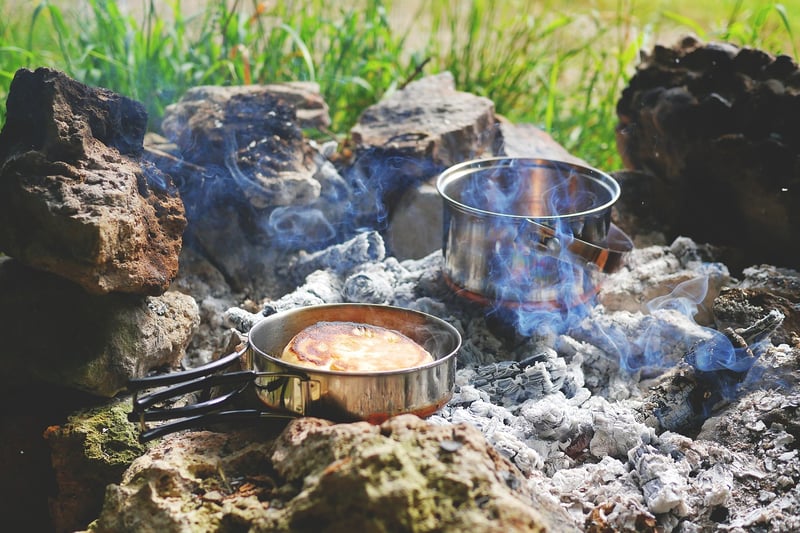
Image credit: Outdoor Cooking Pros
Friday
Dinner: Ratatouille Flatbread
I you pack a pound of frozen pizza dough in your bag it will keep things cool while you get to your campsite, but thaw out in time to make this sweet flatbread. Other than the tomatoes, which can be protected in a Tupperware, the other veggies are hardy enough to pack on their own. Cook the flatbread in a pan with a lid over an open flame, and don’t forget to add your favorite spices (see tip #4 above).
Dessert: Taza Mexican Hot Chocolate
So simple, but so delicious. Taza tells you to start by grating a disc into a cup, but because we don’t want to bring a microplane into the woods, we just crush it up in a plastic bag or with our hands. Then, heat water until just below boiling and mix into the chocolate. If you’re using an unflavored disc, you can add your own cinnamon or nutmeg. Unlike Hershey’s milk chocolate, Taza Chocolate is made with 100% certified organic cacao and contains no artificial flavors, colors or sweeteners. Their dark chocolate is full of healthy fats and antioxidants that actually make this treat feel a whole lot less sinful.
Saturday
Breakfast: Whole Wheat Pancakes and Maple Syrup
Captain Dave’s Pancake and Muffin Mix calls for an addition of one egg and 3/4 cup milk, but if you’re not car camping, you can make your own mix so you can “just add water” while on the trail.
Maple syrup is a natural sweetener that probably came from some of the trees around your campsite. Also, pure maple syrup has a lower glycemic index than other sugars, which means it breaks down over a longer stretch of time and will keep you fueled for a day of hiking. We don’t specifically endorse it, but some cyclists and marathon runners will even down a shot of maple syrup before a big race.
Snack: Trail Mix and Dried Fruit
There’s a reason why this is a classic. Trail mix or GORP (Good Ol’ Raisins and Peanuts) packs a lot of healthy calories into just a few handfuls of yumminess. Try our Organic Trail Mix from Tierra Farms or our new addictive Chocolate, Cranberry and Cashew Mix.
Lunch: Summer Quinoa Salad
Quinoa is a great source of vegetarian protein that can be made ahead of time and eaten on the trail. Add some chickpeas to this mix to keep you full for the rest of the afternoon.
Dinner: Pasta and Roasted Root Vegetables
Pasta and tomato sauce is a shelf-stable no-brainer, but you’ve never had roasted root vegetables until you’ve done it on an open flame in the woods. Make a few pouches with aluminum foil and fill them with a combination of chopped sweet potatoes, parsnips, beats and turnips.
Drizzle in a little maple syrup or honey and a sprinkling of fresh herbs, then close the pouch and shake it to coat. Place it in the fire until the veggies reach a perfect caramelized tenderness and carefully use a stick or a pair of tongs to remove them and unwrap the hot foil.
Dessert: Baked Apples with Brown Sugar and Cinnamon
Replicate the above technique for the roasted root vegetables, but make this one sweet instead of savory.
Sunday
Breakfast: Overnight Oatmeal
Fiddler’s Green Farm makes a mean Irish Oats Hot Cereal that you should try at home if you haven’t already. But the best part about bringing it camping, is that you can use their Quick Recipe instructions to save valuable fire fuel and help you get on the trail at the crack of dawn.
The night before, bring 1/4 cup of oats, 1 cup of water and a pinch of salt to a boil, stir, remove from heat and cover tightly. It will soak overnight so all you’ll need to do in the morning is bring it back up to a simmer for 5 minutes before you’re ready to enjoy with a topping of crushed nuts and a drizzle of maple syrup.
Lunch: Salami with Cheese, Dates and Bread
Unlike most other deli meats, salami lasts for a fairly long time without refrigeration as long as its casing is unopened. We suggest getting a brand of good, organic salami, like Olli Salumeria, that comes with a thick casing to protect it from the elements.
Once opened, you should consume the whole salami within three days, but it makes a great snack for weekend hikes. We like pairing it with sweet Medjool dates, but the salty meat goes well with all sorts of lots of dried fruits.
Once you have your menu planned, you can go to the Boston Organics website and order all of the healthy, organic ingredients you need.
While you're deciding which trail to hike and how many pairs of socks to pack (hint: always bring one more than you think you'll need), we'll bring it all right to your door so you can spend more time outdoors and less time in the supermarket.
What do you like to eat when you go camping? Share your favorite campsite recipes with the Boston Organics Community in the comments below.



